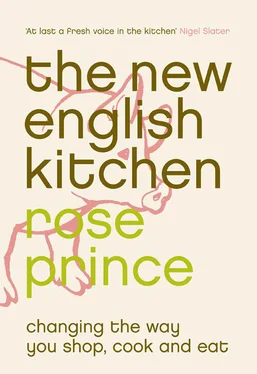For the sauce, combine the yoghurt with the olive oil and salt in a bowl. Scatter the black onion seeds on top and serve with the baked chick peas.
Buying sacks of British potatoes at the roadside, even in cities, is a great economy. They should be sold in paper sacks to keep the light away from them and prevent them turning green. I now keep a metal dustbin outdoors for potatoes but as long as you store them in a cool, dark place they should be fine.
Looking at the supermarket shelves, you would think that only two or three potato varieties grow in the UK. It’s not that Maris Piper, King Edwards or Desiree are dull, simply that there are dozens of other varieties in danger of vanishing unless there is a demand for them – and we, the cooks, are missing out. Many of them are lovely, with colours ranging from white to yellow, and purple to a strange blue-black. Some are waxy, some are earthy and fibrous, some even taste of lemons or chestnuts. Seek out Kerrs Pink, Shetland Black, Wilja and Golden Wonder, as well as some interesting varieties of new potato (see the Shopping Guide). The types of potato grown in domestic gardens are more exciting still – these are the places where you will find old-fashioned varieties such as British Queen, Arran Pilot, Majestic, Suttons Foremost and the various Pentlands.
I would always choose British potatoes over imported but there is a window, between March and May, when supplies are low and the quality is frankly poor. I compromise by buying imports from Cyprus and Spain. I look out for organic when I can, as I do with British potatoes, for clear reasons:
The season for organic potatoes in Britain is shorter than that for conventionally grown potatoes. The first organic new potatoes are dug in late April/early May and the first large, storable potatoes arrive in shops in September. The late arrival is due simply to the slower growth rate – conventional potatoes grow fast with the help of fertiliser and a lot of water. Using less water and allowing the potato to grow at a natural rate not only strengthens it, protecting it from disease, but it gives the potato more flavour. Here is an instance where there is no doubt at all that an organic food has more flavour than its conventional counterpart. Ordinary potatoes are routinely treated with anti-blight spray – their fast growth means weaker plants that need frequent treatment. They are also treated with sprout suppressants and insecticides after harvest. Organic farmers find that growing several types of potato throughout the season in soil that has been well nourished with manure will also help control disease, but they are allowed to spray with copper to prevent blight. Copper treatments are controversial, as residues remain in the soil, but still greatly preferable to the numerous chemical treatments used on conventional potato farms.
Potatoes are caught up in the supermarkets’ price wars – sold at less than their value in order to attract customers. Some poorly flavoured varieties are sold for just a few pence per kilo. The real price of the best conventionally farmed potatoes should in fact be up there with the price of organic potatoes, odd as it may seem. This is around £1.40 per kilo. With a kilo of potatoes yielding about five helpings, that’s 28 pence per helping – still a bargain for a high-quality food.
Dripping or duck fat is ideal for making really crisp roast potatoes but you can get a good result with vegetable oil using the following method. I routinely sprinkle flour on to the potatoes after the par-boiling stage because it guarantees crispness, especially in summer when potatoes can be watery, but you can leave it out if you wish.
1 large, floury potato per person, plus a couple more for good measure
a little flour for sprinkling
dripping, duck fat or vegetable oil
About 1 1/ 4hours before you are due to eat, peel the potatoes and cut them into a shape you like. I cut them lengthways into quarters for a sleek look. Put them in a large pan, cover with water and bring to the boil. Simmer for 5 minutes, then drain in a colander and leave them there to steam for a minute. Sprinkle with a light coating of flour and shake the potatoes around in the colander.
Heat some fat in a separate roasting tin or, if there is room, in the tin you are roasting your meat in. The fat should be about 5mm/ 1/ 4inch deep. When it is hot, lift out each potato from the colander and place at even intervals in the tin. Place in the oven and roast until tender and browned – you will probably have to take them out of the oven and turn them over once.
more roast winter vegetables
About half an hour before you serve the roast, slice 1 sweet potato, cut 3 medium parsnips into quarters lengthways and peel a small squash – any sort – and cut it into slices 1cm/ 1/ 2inch thick. Add them to the tin with the roast, or the roast potatoes, if there is room. Or heat some fat in a separate tin and roast for 25 minutes.
The season for large potatoes that will keep through the winter begins in August. Cooking too many potatoes is a habit of mine, probably brought about by greed. Before I had children, we always had lots of roast potatoes left over, and I used to fry them until crisp and eat with peppery or bitter greens such as rocket, watercress or curly endive. They become yet more colourful with the addition of diced red chilli and dabs of black olive tapenade.
Leftover potato peelings that are clean and unblemished can be shallow-fried, preferably in dripping or groundnut oil, until crisp. Serve with soured cream and a chilli sauce.
You need only a few leftover roast potatoes – or parsnips if you routinely add them to your roasts – to make a heartening soup for very cold weather.
Serves 4
6 roast potatoes or parsnips, cut into cubes
1 large onion, chopped
600ml/1 pint milk
600ml/1 pint chicken or beef stock
salt and freshly ground black pepper
Put the potatoes or parsnips, onion, milk and stock in a pan and bring to the boil. Simmer for about 20 minutes, then cool slightly and liquidise until very smooth. Reheat gently, season to taste, and serve in large bowls, with maybe some chopped fried bacon to make more of a meal of it.
This is easily the most useful of all types of cooked potato and, like rice, it keeps well in the fridge in a sealed container. If it begins to discolour, I throw it away immediately. Milk adds lightness to mash – and scalding it accentuates the potato flavour.
Makes about 10 helpings
2kg/4 1/ 2lb old potatoes, peeled
300ml/ 1/ 2pint milk
60g/2oz butter
sea salt and freshly ground black pepper
Boil the potatoes in a large pan of salted water until soft (test by spearing a potato with a sharp knife and holding it just above the pan; if the potato falls off the knife after a second, it is ready – if it sticks, it is not). Drain in a colander and leave in the colander for 10 minutes to steam. The more liquid that leaves the potato, the better the mash. Some people put their (metal) colander of potatoes in a preheated oven for a few minutes, to be sure.
You can either mash the potatoes in the traditional way with a potato masher or purée them through a food mill (mouli-légumes). Then heat the milk to boiling point in a separate pan and beat it into the potato with the butter. Season to taste.
Peeling the potatoes before cooking is an old habit, and I know that boiling potatoes with the skin on works beautifully, too. Doing this means slipping off the potato skins when they are still hot. It’s up to you.
Читать дальше












